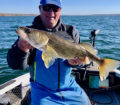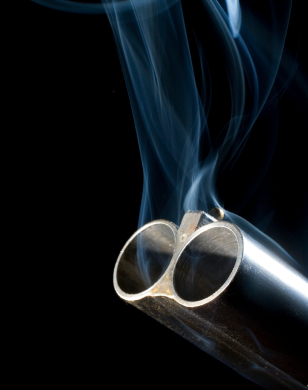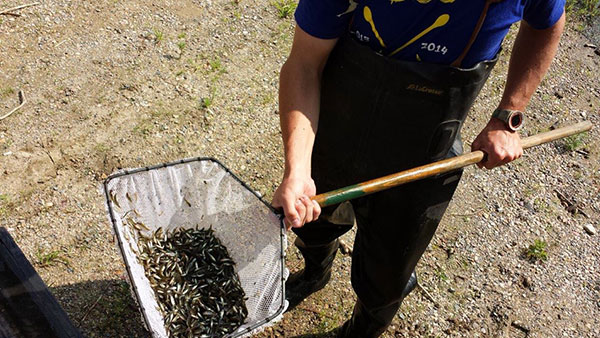By Bob Jensen
Fishing the Midwest Fishing Team

(photo by Bob Jensen) This shallow water, early season walleye at a jig that this angler softly hopped along the bottom.
The open water fishing season is approaching. In fact, it has arrived in some areas of the Midwest, and also in fact, it’s always open water season below the dams on some rivers. Regardless of where you’re fishing and what you’re fishing for, early in the open water season, jigs are the Number One go-to bait for many anglers.
There’s a reason for that: Jigs fool lots of fish into biting. Many anglers, if they were limited to one type of lure to use year ‘round, would choose a jig. Jigs come in a lot of shapes, sizes and colors. Determining which jig you should tie onto your line can be a little confusing. It doesn’t need to be. Just keep a few considerations in mind and you’ll be catching fish on jigs in no time.
Let’s first consider color. Sometimes color matters, sometimes it doesn’t. Go with bright colors in stained or dirty water, more natural colors in clear water. If you’re using plastic on the jig, use a jig of one color and plastic of another color.
By doing so, you’re showing the fish two different colors and increasing the odds of showing the fish the color they want. Rage Swimmers are the plastic that more and more anglers are attaching to their jig. Go with smaller ones in clear cold water and increase the size as the water warms or as it stains.
Next consideration: Hook style. When using plastic, go with a jig with a longer shanked hook. These jigs usually have keepers which prevent the plastic from sliding down the hook, and the longer shank gets the hook farther back in the plastic to increase hooking percentages.
If you’re using live bait, a short-shank hook is preferred. The short shank enables a compact bait presentation that is more desirable in the cold waters of spring or whenever the fish are finicky. Put the hook in the minnow’s mouth and out the hard part of its head and the minnow will stay on your jig longer.
If you’re dragging your jig with live bait, consider a stand-up head. These jigs stand up when they’re sitting on the bottom, so your live bait stands up also. It’s easier for fish to see a stand-up jig presentation when you’re dragging the jig. The stand-up style also comes through weeds cleaner.
Last of all, when the water is stained or if you’re swimming the jig, consider a jig with a spinner or propeller attached. These add flash, which is helpful in stained water, and sometimes fish even in clear water like that additional flash.
The weight of the jig is maybe the most important consideration. Spring walleyes can be found in only two or three feet of water in some places, and they’ll be found deeper in other places. Often a sixteenth ounce jig is big enough, other times you’ll need to go to a quarter ounce or even heavier. Use a jig heavy enough to maintain bottom contact, but not so heavy that it gets snagged frequently.
Six pound test line on a medium or medium light action rod is a good set-up most of the time. In recent years I’ve been using lighter action rods that are in the 6.5 to 7 foot range. I think that the lighter action results in more hookups. With a lighter action when a fish takes your jig, it won’t feel the resistance that it would with a stiffer tipped rod. The lighter action also allows an angler to cast a light jig farther. Lew’s has a nice line-up of walleye rods designed specifically for jigging that do an outstanding job.
Most anglers have some experience with jigs; many anglers have lots of experience with them. If you keep these basic ideas in mind when you’re trying to figure out which jig to tie on, you’ll jig your way to more fish.


















